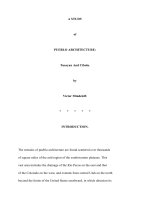CrazY ''''08 How a Cast of Cranks, Rogues, Boneheads, and Magnates Created the Greatest Year in Baseball History ppt
Bạn đang xem bản rút gọn của tài liệu. Xem và tải ngay bản đầy đủ của tài liệu tại đây (1.69 MB, 398 trang )
CAIT MURPHY
Y
'08
How a Cast of
Cranks, Rogues,
Boneheads, and
Magnates Created
the Greatest Year
in Baseball
History
Craz
o my two biggest fans: my father and mother.
So grandly contested were both [pennant] races, so great
the excitement, so tense the interest, that in the last month of
the season the entire nation became absorbed in the thrilling
and nerve-racking struggle, and even the Presidential campaign
was almost completely overshadowed.
—Sporting Life,
October 17, 1908
TABLE OF CONTENTS
The Hot Stove League
1
Land of the Giants
15
Origins of a Dynasty
35
Chicago on the Make
49
Opening Days
57
72
The Great Sorting
79
Heat and Dust
97
The Guns of August
E p i g r a p h
viii
by Robert Creamer x
xii
Chapter 1–
Chapter 2–
Chapter 3–
T I ME-OUT 1:
Chapter 4–
T I ME-OUT 2: The Murder Farm
Chapter 5–
Chapter 6–
T I ME-OUT 3: Doubleday and Doubletalk
129
Chapter 7–
135
ACKNOWLEDGMENTS
FOREWORD
I NTRODUCT I ON
iv
The Dog Days
151
The Merkle Game
That Other Pennant Race
225
Down to the Wire:
The National League
233
The Merkle Game II
1
ut the Author
Credits
Cover
About the Publisher
Copyright
A u t h o r Q & A
Chapter 8–
T I ME-OUT 4: Baseball’s Invisible Men
167
Chapter 9–
177
Chapter 10–
199
T I ME-OUT 5: The Red Peril and the Red Priestess
Chapter 11–
Chapter 12–
257
T I ME-OUT 6: Curses!
273
Chapter 13-Covering the Bases
277
EP I LOGUE 289
S OURCES 30
NOTES 323
I NDEX 361
Abo
Acknowledgments
one of the pleasures of writing a book is the independence of it:
the author gets to call ’em as she sees ’em. One of the difficulties is the
isolation of it. So I am grateful for the team who helped me through this.
The staffs of the New York Public Library and Tim Wiles and
Claudette Burke at the National Baseball Hall of Fame in Coopers-
town were all professional and helpful.
My informal writing seminar—Mary Child, Timothy Dumas,
Humphrey Hawksley, Christopher Hunt, and Margaret O’Connor—
helped me through some rough patches. Robert Creamer not only
wrote a warm introduction, but also read the manuscript with his
characteristic eye for detail. Gretchen Worth and Zack opened their
Bangkok home to me in a bleak midwinter; Gretchen also read the
manuscript. The late Constance Laibe Hays, a good friend and a good
writer, not only encouraged me but also gave me the best single advice
for a writer of nonfiction: do the footnotes as you go along.
The management at Fortune magazine was generous in allowing
me the time to write.
My agent, Rafe Sagalyn, pressed me to make this better than it
would have been; my editor, T. J. Kelleher, did make it better.
My family was unfailingly supportive, though I admit to some
pleasure not having to answer again, “So how’s the book going?” My
father, John Cullen Murphy, did not live to see publication, but it is to
him I owe the idea behind Crazy ’08.
Foreword
by Robert W. Creamer
Author, Babe: The Legend Comes to Life; Stengel: His Life and
Times, and Baseball in ’41: A Celebration of the Best Baseball
Season Ever; former executive editor, Sports Illustrated.
crazy ‘08
is an extraordinary book, maybe the very best of the
many excellent histories that have been written about specific years in
baseball history. Cait Murphy has picked 1908, that memorable sea
-
son almost a century ago during which so much happened and about
which so much has been written. It was the year of Fred Merkle, a
good ballplayer who is indelibly remembered because of one play that
season—a season spiced by the presence of a trio of infielders who
passed into baseball legend because of a newspaper jingle by Franklin
P. Adams about “Tinker to Evers to Chance.” Not great poetry, but
good enough to make the anthologies and to slide the trio into base-
ball’s Hall of Fame.
Murphy salutes the earlier work on 1908, but what she has to say
goes far beyond a simple rehash of the old stories. Her research is
simply remarkable. She guides you into and out of the game on the
field, providing specifics about players and events, eye-opening stories
far beyond humdrum history. She gives you the boisterous city of
Chicago (home of Tinker, Evers & Co.) as it was almost a hundred
years ago, before the proliferation of radio, television, airplanes, auto
-
mobiles, computers, cell phones, ATMs, BlackBerrys, and the like.
She makes you feel what New York City was when John McGraw
was riding high, what America was like, what people were like.
Murphy does this without clogging her story with the tedious
detail that can hamper so much history—baseball and otherwise. She
CRAZY '08
writes with a bounce and a flair and a vigor that grabs you by the arm.
She propels you through the hurrying crowds in Chicago’s Loop to a
politician’s lair; guides you into the packed grandstands in New York’s
Polo Grounds; pops you into Cleveland or Philadelphia or Boston.
She writes about the present, and her present is early twentieth-
century America. She doesn’t give a clichéd picture of Ty Cobb from
the far end of his long and unpleasant career, but a vivid image in 1908
of a slender, twenty-one-year-old wiseass coming into his second full
major-league season with one batting title already under his belt. She
whips us from field to dugout to clubhouse and to banks and board
-
rooms and city halls without missing a beat. You might think her back-
ground as a writer for Fortune magazine, dealing with business and
economics, could weigh down her prose, but you would be wrong.
She bops, if you’ll forgive an antique verb that she probably wouldn’t
use. Her prose bounds along. It moves.
Her professional writing background gives her a jump-start on
seeing the often disquieting realities underlying the time-encrusted
stories of the game on and off the field in the “good old days.” Her
spring training, for example, isn’t the antiseptic, analytical baseball
laboratory of today, nor is it the relaxed, anecdote-telling circuit Red
Smith traveled so pleasantly half a century ago. It’s a rowdy, ram
-
shackle, often badly organized, sometimes dangerous, sometimes hilar-
ious adventure. And it was an integral element of the odd, vigorous
world that baseball was part of in 1908, a crucial year, as Cait Murphy
makes clear, in the history of what was then, without question, our
national pastime.
Crazy ’08 is fun to read, and it’s an education, too. To amuse and
inform: What more can you ask of a writer?
xi
Introduction
in the dreary months when baseball is sleeping, an easy way to
pick a fight with a fan is to ask: What was the best season in baseball
history? The 1991 season has its partisans, when the Twins and Braves
both went from worst to first, then fought a seven-game World Series,
won in classic fashion in the bottom of the tenth, 1-0. And 1986 had
thrilling play-offs and a truly great World Series, which turned on a
ball scooting between Bill Buckner’s hobbled legs. Or maybe 1978,
when Bucky “##&!@$#” Dent hit a certain home run in a one-game
play-off. Then there is 1964, when the Cardinals, led by the implacable
Bob Gibson, ran down the pholding Phillies in the last weeks of the sea
-
son. Or 1951, when Bobby Thomson hit the shot heard ’round the
world. Or 1941, when the Yankee Clipper and the Splendid Splinter
performed unmatchable feats (a fifty-six-game hitting streak, and a
.406 batting average) in the shadow of war. Or the strange doings of
1930, when hitting reached improbable heights. Or even 1919, the
year that almost killed baseball, when gamblers stole a World Series.
They’re all wrong.
The best season in baseball history is 1908. Besides two agoniz-
ing pennant races, it features history’s finest pitching duel, hurled in
the white heat of an October stretch drive, and the most controversial
game ever played. The year is full of iconic performances by baseball’s
first generation of iconic heroes. Tinker, Evers, and Chance are near
their prime. Honus Wagner may have the best season of the century.
Ty Cobb would kick, snarl, and manhandle the Tigers into contention;
Christy Mathewson has his finest season, and his most sorrowful one;
Napoleon Lajoie would never come closer to a pennant. Cy Young,
CRAZY '08
the only man with more than five hundred wins, has his last good
season, while Walter Johnson, the only other man with more than
four hundred, has his first. Shoeless Joe Jackson would come up from
South Carolina, sniff major-league cooking for five games, and decide
it wasn’t for him. Smokey Joe Wood and Tris Speaker have a few
cups of coffee. In the dugouts are Connie Mack and John McGraw.
The two managers, opposites in temperament, are united in their pas
-
sion for the game; they rank first and second in games won.
Every baseball season is like a Dickens novel—a tale told in install-
ments, until in the last chapter, known as the World Series, all the
loose ends are tied up and the heroes go home, tired but happy. In
1908, there are simply more chapters, more incidents, more characters,
more surprises, and more drama than in any other. Six teams are in
contention with two days left; in each league, the pennant is decided
on the last day, the culmination of six months of hard-fought and
sometimes bitter baseball.
Baseball in 1908 has riots and deaths; scandal and arrests; the
bizarre (stealing first base) and the beautiful (a perfect game); the sub-
lime (the Brown-Mathewson pitching duels) and the ridiculous (any-
thing to do with Rube Waddell). In 1908, players take the vaudeville
stage, knockwurst is sold from wicker baskets, and poetry appears on
the sports pages.
The whole season is rife with drama—comic, tragic, odd, and
merely incredible. There is, for example, the curious incident of the
dog in the daytime. And McGraw brawling with a former player in
the lobby of an elite Boston hotel. Not to mention Mathewson being
fished out of a shower to save a game. Oh, and a player hauled off the
field by the cops, a swarm of gnats, and assorted mobbings, feuds, and
hoodoos.
For followers of the Cubs, 1908 has a special resonance: The
season marks the high point of an era of unparalleled success that is
shortly to end. Unlikely as it now seems to link the words “Cubs” and
“dynasty,” that is exactly what they are in 1908. From 1906 through
1910, the Cubs win a record 530 games, four pennants, and two
World Series. Chicago’s accomplished play is driven by a toughness
xiii
Introduction
and competitive fire that makes them the era’s dominant team. In a
ticklish moment in 1908, player-manager Frank Chance asks, “Who
ever heard of the Cubs losing a game they had to have?” The question
is arrogant, and the Cubs do lose some crucial games. Almost a cen
-
tury later, though, it is the attitude that impresses. Any Cub today
with the nerve to repeat Chance’s rhetorical question would evoke, at
best, an incredulous snicker.
In 1908, only boxing and horse racing rival baseball in popularity,
but they carry a whiff of vice about them that can be off-putting. As
for other sports, football is for college boys, basketball is in its infancy;
tennis and golf are for the rich. Baseball, the all-American game, is
seen as both pure and democratic. And unlike other sports, baseball
provides a source of cohesion and pride for residents of fast-growing
cities such as Pittsburgh and Detroit.
With the help of two of history’s best pennant races, twenty
thousand to thirty thousand people pour into ballparks in 1908, rou
-
tinely in New York and Chicago and occasionally elsewhere. Tens of
thousands more block traffic or fill concert halls to watch electric
scoreboards by the hour. The sight of fans literally dying to get into
the game awakens management to baseball’s larger possibilities. In
1908, baseball comes of age.
xiv
THE HOT STOVE LEAGUE
Then it’s hats off to Old Mike Donlin
To Wagner, Lajoie, and Cobb . . .
Don’t forget Hal Chase and foxy Mr. Chance
Who are always on the job . . .
Good old Cy Young we root for,
And Fielder Jones the same . . .
And we hold first place in our Yankee hearts
For the Stars of the National Game.
—performed on vaudeville by
Mabel Hite and Mike Donlin
1
small minds might check the schedule and conclude that the
1908 season begins on Opening Day, April 14. They would be wrong.
The 1908 season began the instant that the last Detroit batter popped
up for the last out of the 1907 World Series.
Having lost to the mighty Cubs 4-zip (with one tie), the Tigers
limped home to lick their wounds. Their poor performance was par
-
ticularly galling since they had shown true grit down the stretch, beat-
ing the Philadelphia Athletics in a pennant race that the New York
Times called the “greatest struggle in the history of baseball.” Hyber
-
bole was as common as bad poetry on the sports pages in 1907, but
the Times just might have had it right—albeit only for a year.
1
CRAZY '08
The turning point came in late September. The Tigers had ridden
a five-game winning streak to overtake the A’s. As they faced a three-
game series in Philadelphia—already known for its aggressive fans—
Detroit was anything but complacent. The series would go a long way
toward settling matters one way or the other. The Tigers won the first
game, then a rainout and a Sunday—the city of brotherly love did not
allow ball games on the Sabbath—meant the clubs would play a dou
-
bleheader on Monday, September 30. In the event, only a single game
was played—a seventeen-inning classic.
The A’s jumped out to a 7–1 lead after six innings and Rube
Waddell, the game’s finest left-hander, was cruising. But he lost his
fastball, or perhaps his concentration—the Rube was not wonderfully
well-endowed mentally—and the Tigers scrapped for four runs in the
seventh, then one more in the eighth. In the top of the ninth, they trailed
8–6. Slugger Sam Crawford led off with a single; the next batter was
Ty Cobb. The 1907 season was the twenty-year-old’s breakout year—
as it was, not coincidentally, for the Tigers. Cobb led the league in
hits, average, runs batted in, and stolen bases while confirming his
reputation as a young man as distasteful off the field as he was won
-
drous on it. He dug in, took a strike—and cracked a home run over the
right field wall. Tie game.
The Tigers scored a run in the top of the tenth; the A’s did the same
in the bottom. The game went on; the light thickened; the tension built.
In the bottom of the fourteenth, Detroit’s Sam Crawford drifted
back to catch a fly in an outfield that was packed with fans; Columbia
Park had seats for only fifteen thousand, and the grass was roped off
to provide standing room for thousands more. As Crawford reached
for the ball, a couple of cops crowded him, either to keep the throng
back or to help the A’s, depending on one’s view of human nature. At
any rate, Crawford dropped the ball. The A’s had a man in scoring
position—briefly. Detroit argued that the cops had interfered with
Crawford. There ensued a few minutes of civilized colloquy, marked
by only a single arrest (of Detroit infielder Claude Rossman) and a
trivial riot. Bravely, umpire Silk O’Loughlin decided against Philly,
calling the batter out.
2
The Hot Stove League
What becomes known as the “when-a-cop-took-a-stroll play”
2
loomed large when the next hitter hit a long single, but, of course, there
was no man on second to score. No one else did, either. At the end of
seventeen, the umps ended the game on account of darkness. The box
score called it a tie, but the Tigers felt as if they had won. The A’s
were certain that they wuz robbed. Manager Connie Mack, a kindly
man, was uncharacteristically bitter: “If there ever was such a thing as
crooked baseball, today’s game would stand as a good example.”
3
The controversial tie turned the season. The A’s had lost their
best chance to track down the Tigers, who promptly ripped off five
straight wins on their way to the pennant. Delighted with the team’s
first championship in twenty years, Detroit’s happy multitudes cele
-
brated by lighting bonfires and painting their pooches in tiger stripes.
4
To flop against the Cubs after all that—well, it hurt.
The Cubs, of course, were exultant. They had gone into 1907
determined to erase the insult of losing the 1906 World Series to the
crosstown White Sox, a team they considered—and probably was—
inferior. The Cubs played well all year, finishing ahead of the second-
place Pirates by seventeen games and twenty-five ahead of the New
York Giants, their least-favorite team—a deeply satisfying result to the
Cubs, and a mortifying one to the Gothamites. By finishing off 1907
with such élan, the Cubs restored their sense of superiority. They
strutted home for the winter, their wallets engorged with their World
Series winnings: $2,142.
5
Just because the games are over, though, does not mean that the
game is. Baseball never sleeps; instead, it huddles around the meta
-
phorical hot stove to rehash the past and dicker about the future. Even
in the depths of winter, there is always a thrumming pulse of wakeful-
ness—deals to make, rules to refine, lies to swap, mangers to fire. At
the February 1908 annual meeting of the National League, the air at
the Waldorf-Astoria fairly reeks of smoke and self-congratulation.
Baseball is “in a most prosperous and healthy condition,” concludes
NL president Harry Pulliam in his annual report. “My experience as
president of your organization has been a very pleasant one during the
last summer.”
6
Given what would happen to Pulliam in 1908–1909,
3
CRAZY '08
the words are desperately poignant. Sporting Life, a weekly magazine
that was a reliable barometer of what the bosses were thinking, is also
sunny: “There is not one cloud in sight.”
7
Complacency is as enduring a feature of the game as the hot dog,
but there is reason for it in early 1908. For one thing, the World
Series has been played three straight times, and is already an institution.
For another, attendance has been booming,
8
resulting in handsome
profits—$17 million from 1901–08.
9
The value of every franchise has
multiplied.
Prosperity does not, however, buy wisdom. The game is well on
its way to developing its Micawberish ability to turn a blind eye to
problematic realities. Most recently, it’s steroids; in 1908, it is fan vio
-
lence and gambling. At the league meetings, both subjects are brought
up, then quietly tabled. Perhaps something would turn up.
The owners do fiddle with a few things. In the American League,
John Taylor, owner of the Boston team, decides to redesign the team’s
uniform, switching from light-blue stockings to red ones. Taylor jokes,
“You newspaper men will have to pick a new nickname for my team,”
10
then known as the Pilgrims, and previously as the Collinsites, Puri-
tans, Somersets, and even Yankees(!). He modestly proposes one pos-
sibility: Red Sox.
11
In the NL, the owners decide to require clubs
to play out the whole schedule if any of the games have a bearing on
the pennant race—a reasonable idea that the junior circuit does not
adopt, though it will wish it had. And both leagues toss a couple of
tidbits to the offense, approving the modern rule regarding the sacri
-
fice fly (no at bat if a run scores), and forbidding pitchers from soiling
a new ball.
Pitchers are not happy with this last change. They believe that
new balls are harder to curve, which is debatable. But shiny new balls
are certainly easier to see and go farther when hit. Besides, pitchers
like playing in the dirt. “The umps would give the starting ball” to the
pitcher, recalled George Gibson, a catcher for the Pirates, “and you’d
think he played eighteen innings with it before he pitched the first
ball. There’s a lot of smoke along the railroad tracks [near Pittsburgh’s
Exposition Park], the dust and the dirt, and he’d spit on it, rub it down
4
The Hot Stove League
on the grass. He’d throw it at me, and it would be all colored, all black,
you’d just see a little white spot.”
12
For all the grumbling from the pitcher’s mound—Chicago’s Orval
Overall predicts that “hitting averages will go soaring”
13
—the tidy-ball
rule is not that big a deal, because so few new ones ever make it into
play. Umps are given three at the start of each game. When these are
lost or blasted to smithereens, the home team is required to provide
more, but these could be—and were, if the team was ahead—old and
battered.
14
A typical game in 1908 uses perhaps six to ten balls (com-
pared to eighty-plus now)
15
because fouls hit into the stands are sup-
posed to be returned to play.
Fans didn’t always comply, of course, but the law is on manage-
ment’s side. During batting practice in Brooklyn in April 1908, Giants
manager John McGraw sends police into the stands to intimidate peo
-
ple into returning fouls. Christy Mathewson even tattles on one fan,
16
which isn’t very nice, and the poor fellow is arrested. It is not until
1923 that an eleven-year-old establishes the principle of salvage.
Young Reuben Berman was jailed overnight for the crime of refusing
to return a ball at Philadelphia’s Baker Bowl. In the kind of decision
that affirms one’s faith in the American judicial system, a judge ruled
that “a boy who gets a baseball in the bleachers to take home as a
souvenir is acting on the natural impulse of all boys and is not guilty
of larceny.”
17
After that, foul balls were fair game.
Keeping a few balls clean for a few pitches is the least baseball
could do for hitters, a beleaguered lot in 1908. Scoring has collapsed—
not because the play is deteriorating, the complaint of every baseball
generation about every succeeding one—but because it is getting bet
-
ter. The game, concludes a Cleveland sportswriter in early 1908, “is as
close to perfection as can be.”
18
Baseball is not perfect, but it is far more proficient than even a
decade before. Think of it this way. If you were to beam yourself back
to a 1908 football or basketball game, the play would look unskilled,
the strategies primitive, and much of the action incomprehensible.
Take yourself out to the ball game, though, and you would be right at
home. Other than the abolition of freak pitches (1920), the lowering
5
CRAZY '08
of the pitcher’s mound (1969), and the institution of the designated-
hitter abomination (1973), baseball has had no major on-field rule
changes in the last century. The time-traveling fan would find cos
-
metic differences—outfields that stretched to the horizon, whiskey in
the stands, fans dressed in ties and bowler hats, the occasional sight of
a player smoking on the field,
19
a happy lack of thunder sticks and
Limp Bizkit. Between the lines, though, the game would be entirely
familiar.
The reason is simple. Baseball had folded, spindled, and occasion-
ally mutilated its laws more or less constantly since that autumn day
in 1845 when Alexander Joy Cartwright and a few cronies wrote
down the first formal set of rules. By 1908, the game has reached a
degree of refinement absent from other team sports. Not that the pro
-
cess was smooth. One of Cartwright’s original twenty rules forbade
the balk; thousands of glosses later, this remains one of life’s myster
-
ies. There were, at various times, nine, eight, seven, six, and five balls
for a walk, before the game settled on four, which seems just right.
Pitchers initially had to throw underhand; then they could raise their
arms a bit higher; and finally they were allowed to throw however
they wished. They got so good they threatened to discourage the poor
batter entirely. So the mound was moved back from forty-five to fifty
feet, and back again, in 1893, to the current standard of sixty feet six
inches. Hitters liked this innovation, setting all kinds of offensive
records in 1894.
Then the tide turned. In 1900, home plate was changed from a
square to a larger five-sided slab, adding a useful chunk of space to the
strike zone—thus fewer walks, fewer hits, and fewer pitches per bat
-
ter. In 1901, pitchers got another break when the NL declared the first
two foul balls strikes; in 1903, the AL agreed. No longer could a hitter
slap away pitch after pitch, as he waited for the hard-pressed hurler to
falter (and as he sent fans into a stupor). Hall of Famer Billy Hamilton
once fouled off twenty-nine pitches in a row, a habit that at least one
pitcher was not about to tolerate. When “Sliding Billy”—he stole a
record seven bases in a single game
20
—fouled off one too many against
Cy Young, the pitcher marched toward the batter’s box and warned,
6
The Hot Stove League
“I’m putting the next pitch right over the heart of the plate. If you foul
it off, the next one goes in your ear.”
21
Batters are prone to complain about all this. Napoleon Lajoie,
Cleveland’s great second baseman, whines in 1908, “It’s time they
started helping batters a little, instead of shoving foul-strike rules and
such things against them.”
22
The man may have a point. In 1908, an
average game sees fewer than seven runs, down from almost fifteen in
1894.
23
Batters record the second-lowest average of the twentieth
century.
24
But Lajoie also misses something important. Hitting is still
stuck in the nineteenth century. Pitching and fielding, on the other
hand, have made great leaps forward.
No question: Pitchers consider it their manly duty to go nine innings
or more, and are occasionally left in to suffer humiliating bloodbaths.
Washington’s Burt Keeley pitches a complete game in 1908 in which
he gives up eighteen runs. (He loses.) That said, the use of relief pitch
-
ing is developing. While there are no relief specialists as such, taking
the bum out is common. When Cy Young began his career in 1890,
pitchers finished nine out of ten games. By the time he left the game as
a portly forty-four-year old in 1911, the ratio is down to six in ten.
25
As for the pitchers themselves, it doesn’t hurt that they are bigger
than the average player, by a good inch-and-a-half and almost ten
pounds.
26
They are also very, very good, with a vast armory of weap-
ons at their disposal. The curveball was discovered not long after the
Civil War. As with everything in baseball, the exact origins are much
in dispute, but Arthur “Candy” Cummings got into the Hall of Fame
by making a determined case for authorship.
27
In short order, pitchers
discovered other ways to bend, break, or drop the horsehide. Any
-
thing a modern pitcher can do with a ball the pitchers in the class of
1908 could, and more. They can apply spit, slime, mud, soap, licorice,
or tobacco juice, or scrape, sand, or puncture it—anything short of tak
-
ing an ax to it.
28
Pitchers in 1908 have other advantages their modern brethren
would sink their mothers for. The strike zone is high because catchers
stand, knees bent, rather than squat; and the balls are often misshapen
and dented, which hurts the fielders some, but batters more. It must
7
CRAZY '08
have been soul-destroying to hit a pitch squarely, only to hear the soft
thud of wood against mush. “Deadball”—the term used to describe
baseball from 1901 to 1919—is not just metaphor.
Behind the pitcher, baseball defense has also marched steadily up
the evolutionary ladder. Isaac Newton was no ballplayer, but he said
something important about the game when he wrote, “If I have seen
further, it is by standing on the shoulders of giants.” Baseball is Dar
-
winian in its results, but Newtonian in its processes. With rigorous
empiricism, fielders built up a solid foundation of knowledge through
generations of trials and thousands of errors. Their peer-reviewed
results quickly become standard operating procedures. Charles Comis
-
key, during his playing days in the 1880s, was among the first to play
well off the first-base bag.
29
The advantages were obvious, and soon
everyone was doing it. Ditto for things like the pitchout and the hit-
and-run, comparatively recent innovations that by 1908 are routine.
The language of defense is also highly evolved. In a typical exam-
ple of on-field communication, circa 1908, the Cubs’s catcher puts
down a finger, then holds his hand on the top of the mitt—a signal for
a fastball high and outside. Second baseman Johnny Evers catches the
drift, and passes the information on to shortstop Joe Tinker, who
touches his glove: Message received. Evers’s next move is to rest his
hand on his hip, to tell the outfield what is coming. As the pitcher, Ed
Reulbach, begins his windup, all the fielders cheat a few steps to their
left, toward the area where a right-handed batter is likeliest to hit an
outside pitch. Reulbach throws to the designated spot, and the batter
hits the ball to what would have been the gap between first and sec
-
ond but isn’t, because Evers is already on his way there. Out.
The Cubs are the acknowledged masters of this kind of play, but
everyone does it to some degree. When Ty Cobb was at bat, for exam
-
ple, and wanted to start a hit-and-run, he would touch, say, his pants,
arm, and shirt: three touches, or any odd number, signaled the runner to
go on the next pitch. Unless, that is, the team had decided to switch to
even numbers for the game, or even just that inning.
30
Timing plays, audi-
ble signals, fakes, double-fakes, even the use of stopwatches to time the
pitcher’s throw to the plate:
31
baseball in 1908 is anything but crude.
8
The Hot Stove League
Defense also benefits from generally improved playing conditions.
Compared to today’s lushly manicured emeralds that play with the
consistency of pool tables, the fields of 1908 are rough. Outfielders in
Detroit’s Bennett Park, built over a former open-air hay market, some
-
times trip over the cobblestones lurking beneath the thin cover.
32
Tommy Leach of the Pirates occasionally borrows a rake to smooth
out the area around third base.
33
At the Huntington Avenue Grounds,
home of the Red Sox, center field slopes uphill, and there is a toolshed
in play.
34
Nevertheless, the players know that the fields are far better
than in the 1890s, when the Baltimore Orioles could hide extra balls
in the wilderness that was their outfield.
35
And the Orioles field was positively pristine compared to those
of the decade before that. In 1882, Charles Radbourn was playing at
home for Providence, then a major-league city. In an extra-inning game,
Radbourn, who was known more for his pitching than his batting (he
won fifty-nine games in 1884), crushed a pitch to left field. The ball
dropped and rolled toward a line of carriages that formed the de facto
boundary, coming to rest near a horse. When the outfielder, Detroit’s
George Wood, reached for the ball, the beast—clearly a souvenir
hunter—kicked. Wood tried again; so did the horse. Radbourn, whose
nickname, appropriately, was Old Hoss, kept galloping around the
bases. Wood tried to distract the horse with grass. No luck. Finally,
another outfielder poked out the ball with a stick, by which time Old
Hoss was headed for the barn.
36
And, finally, there is the glove. The grumpy reactionaries who are
a permanent feature of the baseball landscape blame the glove for the
scoring slump, and disdain it as contrary to the original intent of the
founders. If God had meant fielders to wear gloves, he would have
made their hands of leather. In the old days, we didn’t need gloves . . .
yada, yada, yada. As one 1860s veteran wrote approvingly:
We used no mattress on our hands,
No cage upon our face;
We stood right up and caught the ball
With courage and with grace.
37
9









